Submitted:
22 July 2024
Posted:
22 July 2024
You are already at the latest version
Abstract
Keywords:
1. Introduction
2. Materials and Methods
3. Abu Jir Springs
3.1. Geological and Geomorphological Setting
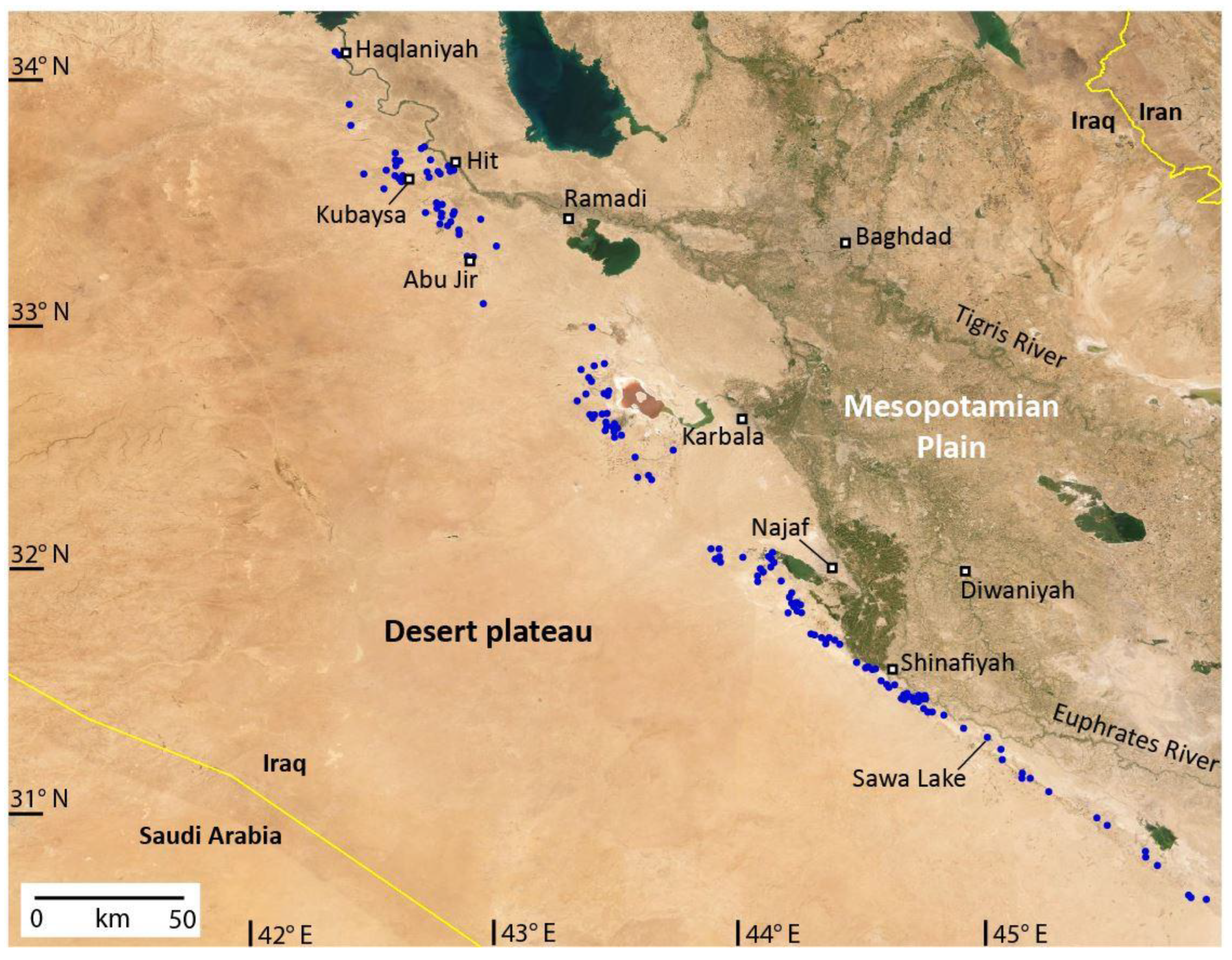
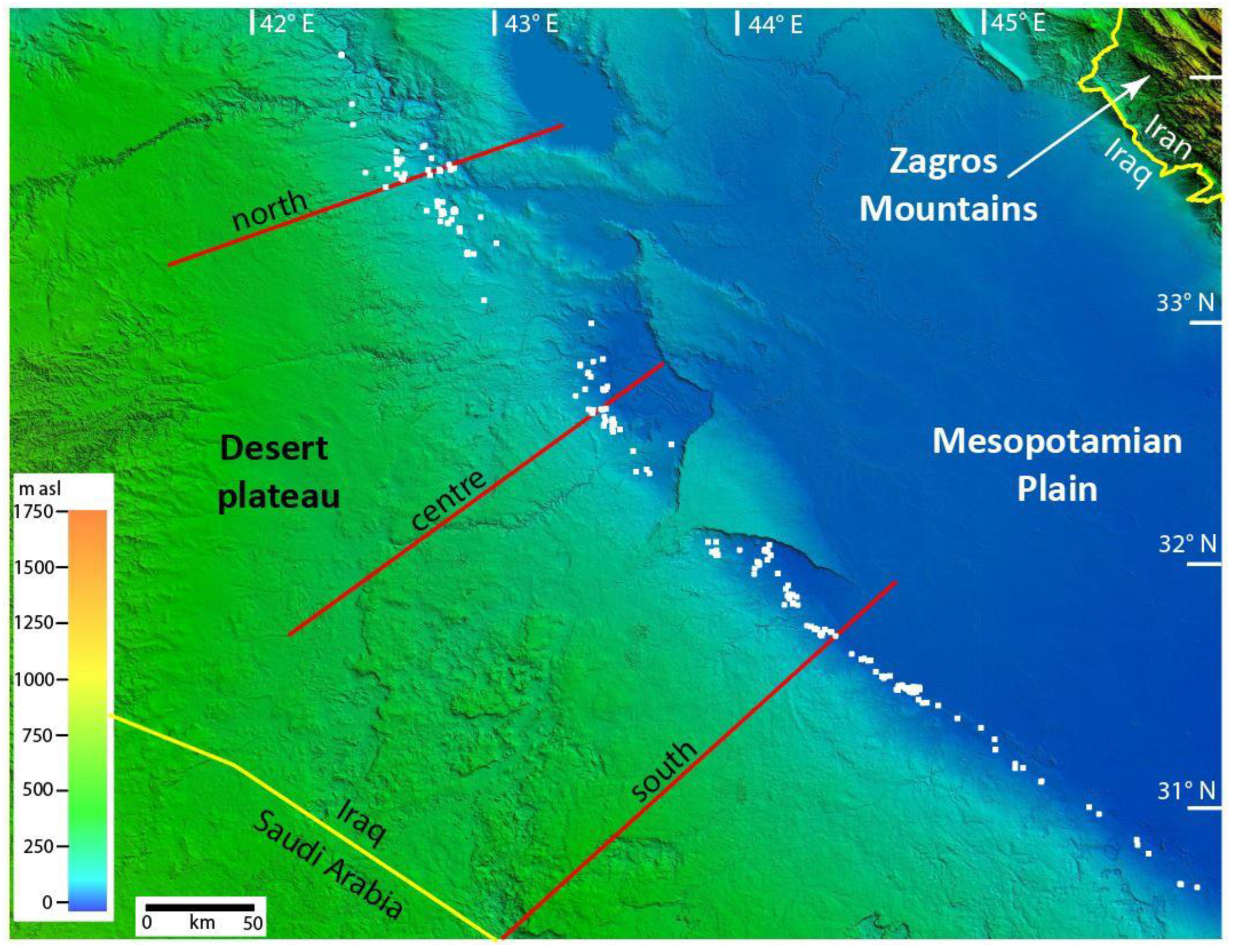
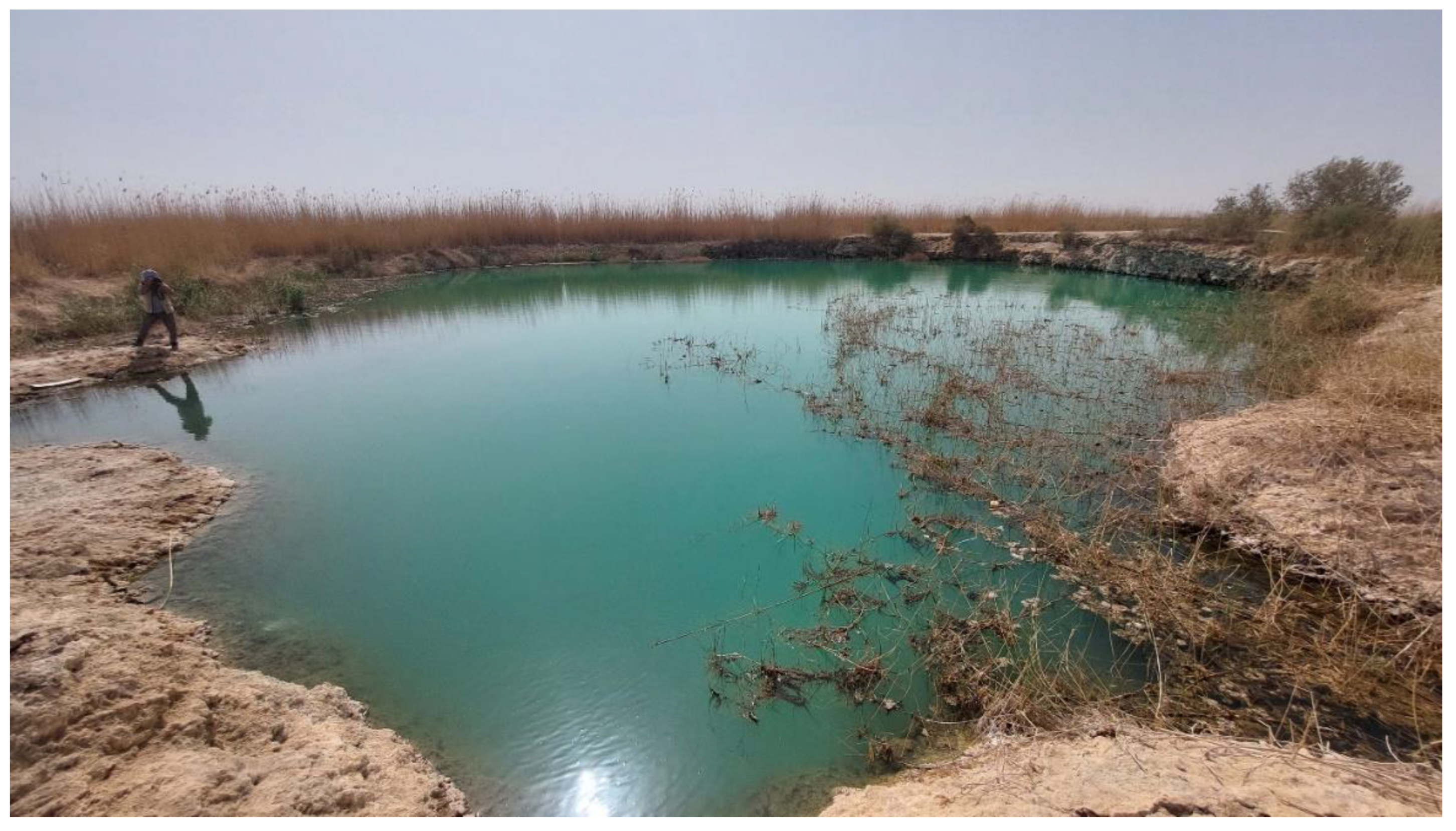
3.2. Hydrogeological Setting
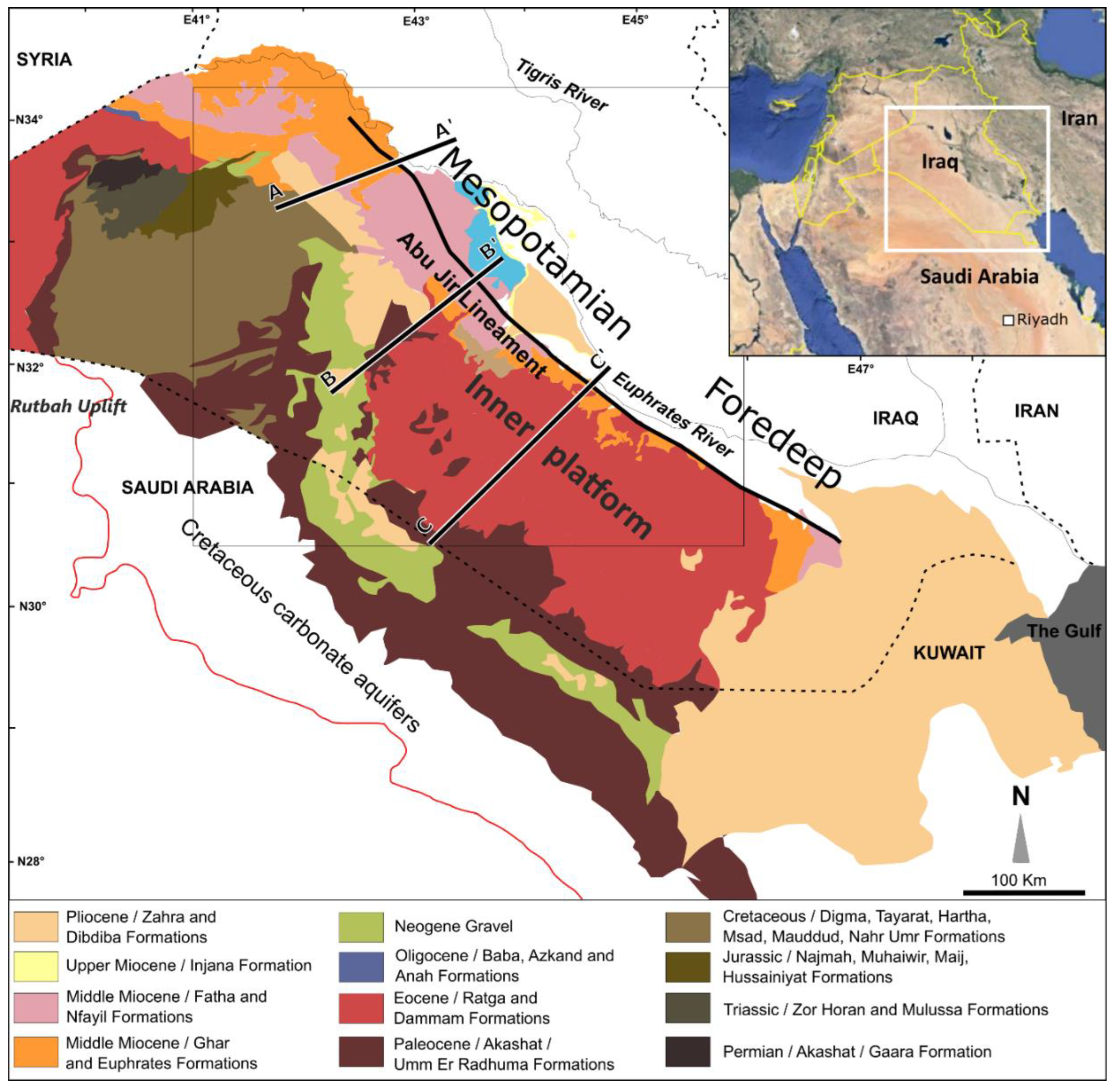
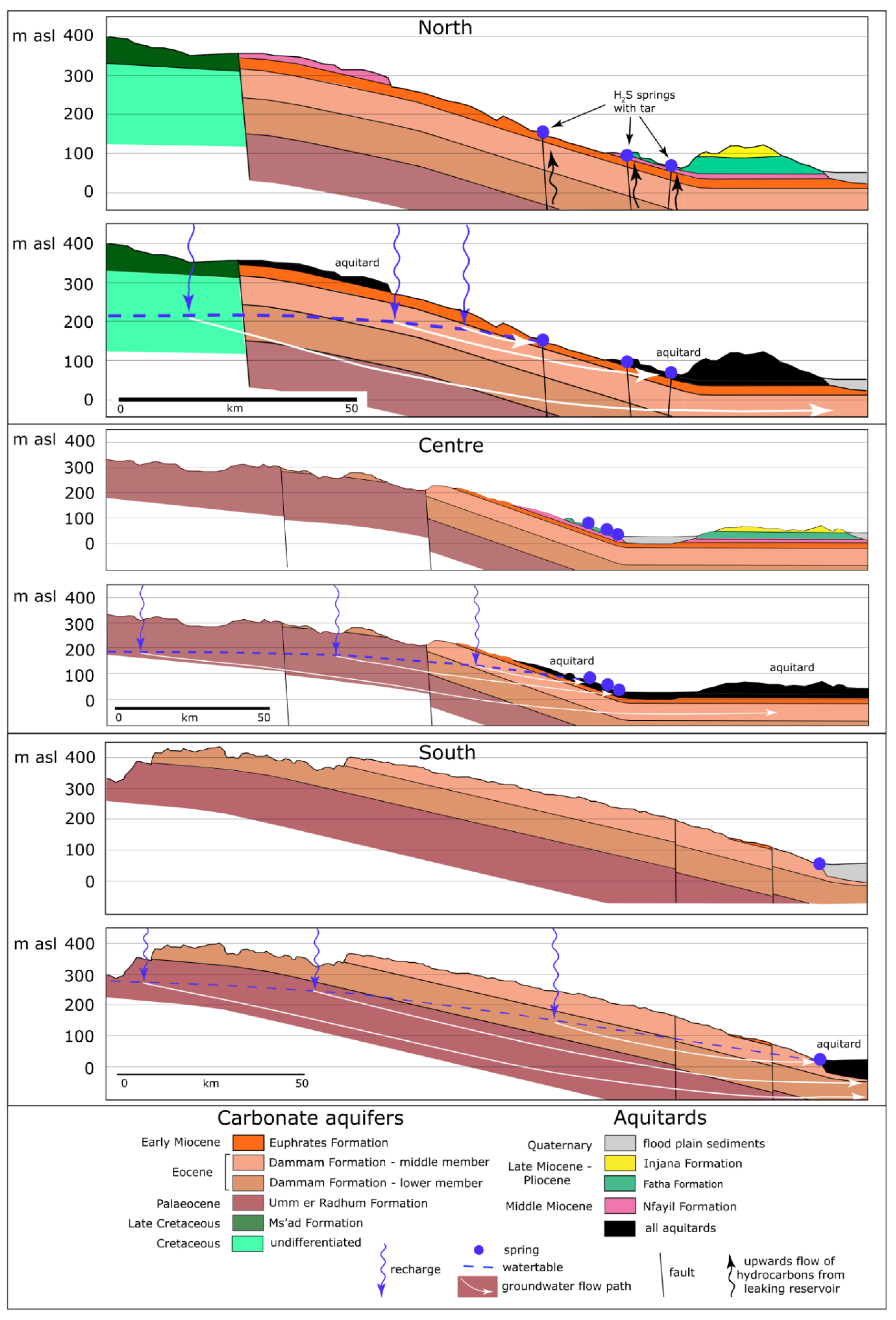
3.3. Hydrogeology of Abu Jir Springs
3.4. Recharge to the Abu Jir Springs
3.5. Hydrochemistry of the Abu Jir Springs
4. Conclusions
Author Contributions
Funding
Data Availability Statement
Conflicts of Interest
References
- Altaweel, M.; Marsh, A.; Jotheri, J.; Hritz, C.; Fleitmann, D.; Rost, S.; Lintner, S.F.; Gibson, M.; Bosomworth, M.; Jacobson, M.; et al. New Insights on the Role of Environmental Dynamics Shaping Southern Mesopotamia: From the Pre-Ubaid To the Early Islamic Period. Iraq 2019, 81, 23–46. [Google Scholar] [CrossRef]
- Sissakian, V.K.; Mohammad, B.S. Geology of Iraqi Western Desert: Stratigraphy. Iraqi Bulletin of Geology and Mining, special issue 2007, 51–124. [Google Scholar]
- Thabit, J.M.; Al-yasi, A.I.; Al-shemmari, A.N. Estimation of Hydraulic Parameters and Prorosity from Geoelectrical Properties for Fractured Rock Quifer in Middle Dammam Formation at Bahr. Iraqi Bulletin of Geology and Mining 2014, 10, 41–57. [Google Scholar]
- Saleh, S.A.; Al-Ansari, N.; Abdullah, T. Groundwater Hydrology in Iraq. Journal of Earth Sciences and Geotechnical Engineering 2020, 10, 155–197. [Google Scholar]
- Mukhlif, H.N.; Rabeea, R.; Hussien, B.M. Characterization of the Groundwater within Regional Aquifers and Suitability Assessment for Various Uses and Purposes-Western Iraq. Baghdad Sci.J 2021, 18, 0670. [Google Scholar] [CrossRef]
- Al-Dulaimi, A.M.S.; Al-Kubaisi, Q.Y. Hydrochemistry and Water Quality Index of Groundwater in Abu-Jir Village in Al-Anbar, Western Iraq. IGJ 2022, 55, 73–84. [Google Scholar] [CrossRef]
- Al Maliki, A.; Kumar, U.S.; Falih, A.H.; Sultan, M.A.; Al-Naemi, A.; Alshamsi, D.; Arman, H.; Ahmed, A.; Sabarathinam, C. Geochemical Processes, Salinity Sources and Utility Characterization of Groundwater in a Semi-Arid Region of Iraq through Geostatistical and Isotopic Techniques. Environ Monit Assess 2024, 196, 365. [Google Scholar] [CrossRef]
- Awadh, S.M.; Al-Ghani, S.A. Assessment of Sulfurous Springs in the West of Iraq for Balneotherapy, Drinking, Irrigation and Aquaculture Purposes. Environmental Geochemistry and Health 2014, 36, 359–373. [Google Scholar] [CrossRef]
- Al-Dahaan, S.A.J.M.; Hussain, H.M.; Al-Ansari, N.; Knutson, S. Hydrochemistry of Springs, Najaf Area, Iraq. Journal of Environmental Hydrology 2015, 23, 1–12. [Google Scholar]
- Al-Dahaan, S.A.J.M. Origin and source of springs west Iraq. Journal of Kufa Physics 2014, 6, 1–12. [Google Scholar]
- Al-Dahaan, S.A.M.; Alabidi, A.J.; Al-Ansari, N.; Knutsson, S. Relationship between Selected Hydrochemical Parameters in Springs of Najaf Province, Iraq. Engineering 2015, 7, 337–346. [Google Scholar] [CrossRef]
- Hussien, B.M.; Gharbie, M.A. Hydrogeochemical Evaluation of the Groundwater Within Abu Jir Fault Zone, Hit – Kubaisa Region, Central Iraq. Iraqi Bulletin of Geology and Mining 2010, 6, 121–138. [Google Scholar]
- Casana, J.; Jackson, C. The CORONA Atlas Project: Orthorectification of CORONA Satellite Imagery and Regional-Scale Archaeological Exploration. In Mapping archaeological landscapes from space, 5; Comer, D.C., Harrower, m J., Eds.; Springer Science Business and Media, 2013.
- Philip, G.; Donoghue, D.; Beck, A.; Galiatsatos, N. CORONA Satellite Photography: An Archaeological Application from the Middle East. Antiquity 2002, 76, 109–118. [Google Scholar] [CrossRef]
- Musil, A. Arabia Deserta; The American Geographical Society: New York, 1927. [Google Scholar]
- Schoeller, H. Qualitative Evaluation of Groundwater Resources. In: Methods and Techniques of Groundwater Investigations and Development; UNESCO, 1965.
- Dean, J.F.; Webb, J.A.; Jacobsen, G.E.; Chisari, R.; Dresel, P.E. Biomass Uptake and Fire as Controls on Groundwater Solute Evolution on a Southeast Australian Granite: Aboriginal Land Management Hypothesis. Biogeosciences 2014, 11, 4099–4114. [Google Scholar] [CrossRef]
- Drever, J.I. The Geochemistry of Natural Waters. Third Edition; Rentice Hall: Hoboken, 1997. [Google Scholar]
- Allison, G.; Hughes, M. The Use of Environmental Chloride and Tritium to Estimate Total Recharge to an Unconfined Aquifer. Soil Res. 1978, 16, 181. [Google Scholar] [CrossRef]
- Dean, J.F.; Webb, J.A.; Jacobsen, G.; Chisari, R.; Dresel, P.E. A groundwater recharge perspective on locating tree plantations within low-rainfall catchments to limit water resource losses. Hydrology and Earth System Sciences 2015, 19, 1107–1123. [Google Scholar] [CrossRef]
- MacDonald, A.M.; Lark, R.M.; Taylor, R.G.; Abiye, T.; Fallas, H.C.; Favreau, G.; Goni, I.B.; Kebede, S.; Scanlon, B.; Sorensen, J.P.R.; et al. Mapping Groundwater Recharge in Africa from Ground Observations and Implications for Water Security. Environmental Research Letters 2021, 16. [Google Scholar] [CrossRef]
- Yacoub, S.Y. Stratigraphy of the Mesopotamia Plain. Iraqi Bulletin of Geology and Mining 2011, 4, 47–82. [Google Scholar]
- Abdulnaby, W. Structural Geology and Neotectonics of Iraq, Northwest Zagros. In Tectonic and Structural Framework of the Zagros Fold-Thrust Belt; Saein, A.F., Ed.; Elsevier, 2018; pp. 53–73 ISBN 978-0-12-815048-1.
- Sissakian, V.K. Geological Evolution of the Iraqi Mesopotamia Foredeep, Inner Platform and near Surroundings of the Arabian Plate. Journal of Asian Earth Sciences 2013, 72, 152–163. [Google Scholar] [CrossRef]
- Aladwani, N.S.; Alenezi, A.; Diab, A. Investigation of the Cretaceous Total Petroleum System Using Wireline Logs, Core, and Geochemical Data in Bahrah Field, Northern Basin, Kuwait. Journal of Petroleum Exploration and Production Technology 2023, 13, 381–406. [Google Scholar] [CrossRef]
- Sissakian, V.K.; Fouad, S.F.A. Geological Map of Iraq, Scale 1: 1,000,000. Iraqi Bulletin of Geology and Mining 2015, 11, 1–7. [Google Scholar]
- Geological Survey (USA) Geologic Map of the Arabian Peninsula 1963.
- Alhadithi, A.A.; Salih, E.M. Behavior of Abu-Jir Fault Zone in Al-Thirthar Valley and near Habbaniya Lake Areas – Comparative Study Using Seismic Reflection Sections. Journal of University of Anbar for Pure Science 2017, 11, 47–55. [Google Scholar] [CrossRef]
- Al Dulaymie, A.S.; Hussien, B.M.; Gharbi, M.A.; Mekhlif, H.N. Balneological Study Based on the Hydrogeochemical Aspects of the Sulfate Springs Water (Hit-Kubaiysa Region), Iraq. Arabian Journal of Geosciences 2013, 6, 801–816. [Google Scholar] [CrossRef]
- Fouad, S. Contribution to the Structure of the Abu-Jir Fault Zone, West Iraq. Iraqi Geological Journal 1999, 32, 63–73. [Google Scholar]
- Benischke, R.; Fuchs, G.; Weissensteiner, V. Speleological Investigations in Saudi Arabia.; International Union of Speleology: Switzerland, 1997; Vol. 1, pp. 425–428.
- Waltham, T. Asia, Southwest. In Encyclopedia of Caves and Karst Science; Gunn, J., Ed.; Fitzroy Dearborn: New York, 2004; pp. 114–116. [Google Scholar]
- Barwary, A.M.; Slewa, N.A. Geological Map of Karbala Quadrangle, Sheet NI-38-14 1995.
- Barwary, A.M.; Slewa, N.A. Geological Map of Al-Najaf Quadrangle, Sheet NH-38-2 1996.
- Deikran, D.B.; Mahammad, S.M. Geological Map of Baghdad Quadrangle, Sheet NI-38-10. 1994.
- Sissakian, V.K.; Youkhanna, R.Y. Geological Map of Al-Birreet Quadrangle, Sheet NH-38-1 1995.
- Sissakian, V.K.; Zwaid, Q.A.; Mohammad, S.M. Geological Map of Al-Ramadi Quadrangle, Sheet NI-38-9 1995.
- Mahdi, A.H.; Youkhanna, R.Y. Geological Map of Shithatha Quadrangle, Sheet NI-38-13 1996.
- Al-Zubedi, A.S.; Thabit, J.M. Use of 2D Azimuthal Resistivity Imaging in Delineation of the Fracture Characteristics in Dammam Aquifer within and out of Abu-Jir Fault Zone, Central Iraq. Arabian Journal of Geoscience 2016, 9, 1–9. [Google Scholar] [CrossRef]
- Abdullah, F.H. Porosity and Permeability of Karst Carbonate Rocks along an Unconformity Outcrop : A Case Study from the Upper Dammam Formation Exposure in Kuwait, Arabian Gulf. Heliyon 2021, 7, e07444. [Google Scholar] [CrossRef]
- Al-Abadi, A.M.; Shahid, S. Spatial Mapping of Artesian Zone at Iraqi Southern Desert Using a GIS-Based Random Forest Machine Learning Model. Model. Earth Syst. Environ. 2016, 2, 96. [Google Scholar] [CrossRef]
- UN-ESCWA and BGR Inventory of Shared Water Resources in Western Asia; United Nations Economic and Social Commission for Western Asia; Bundesanstalt für Geowissenschaften und Rohstoffe: Beirut, 2013.
- Faulkner, R.D. Fossil Water or Renewable Resource: The case for one Arabian aquifer. Proceedings of the Institution of Civil Engineers - Water, Maritime and Energy 1994, 106, 325–331. [Google Scholar] [CrossRef]
- Rausch, R.; Dirks, H. A Hydrogeological Overview of the Upper Mega Aquifer System on the Arabian Platform. Hydrogeol J 2024, 32, 621–634. [Google Scholar] [CrossRef]
- Awadh, S.A. The Atmospheric Pollution of Baghdad City, Iraq. In Proceedings of the Proceedings 3rd Scientific Conference College of Science, University of Baghdad; 2009; pp. 1727–1740. [Google Scholar]
- Handy, A.H.; Tucker, R.A. Rainfall Quality at Selected Sites in Saudi Arabia. Water Research and Study Division. Publication No. 2, Vol. 8; Ministry of Agriculture and Water, Water Resources Development Department, 1984.
- Michelsen, N.; Reshida, M.; Siebert, C; Knoller, K; Wiese, S M; Rausch, R; Al-Saud, M; Schuth, C Isotopic and Chemical Composition of Precipitation in Riyadh, Saudi Arabia. Chemical Geology (Isotope Geoscience Section). 2015, 413, 51–62. [CrossRef]
- Al-Dahaan, S.A.J.M. Origin and Source of Springs West Iraq. Journal of Kufa - Physics 2014, 6, 1–12. [Google Scholar]
- Ali, K.K.; Ajeena, A.R. Assessment of Interconnection between Surface Water and Groundwater in Sawa Lake Area, Southern Iraq, Using Stable Isotope Technique. Arabian Journal of Geosciences 2016, 9. [Google Scholar] [CrossRef]
- Awadh, S.M.; Ali, K.K.; Alazzawi, A.T. Geochemical Exploration Using Surveys of Spring Water, Hydrocarbon and Gas Seepage, and Geobotany for Determining the Surface Extension of Abu-Jir Fault Zone in Iraq: A New Way for Determining Geometrical Shapes of Computational Simulation Models. Journal of Geochemical Exploration 2013, 124, 218–229. [Google Scholar] [CrossRef]
- Engelhardt, I.; Rausch, R.; Keim, B.; Al-Saud, M.; Schüth, C. Surface and Subsurface Conceptual Model of an Arid Environment with Respect to Mid- and Late Holocene Climate Changes. Environ Earth Sci 2013, 69, 537–555. [Google Scholar] [CrossRef]
- Bennetts, D.A.; Webb, J.A.; Stone, D.J.M.; Hill, D.M. Understanding the Salinisation Process for Groundwater in an Area of South-Eastern Australia, Using Hydrochemical and Isotopic Evidence. Journal of Hydrology 2006, 323, 178–192. [Google Scholar] [CrossRef]
- Imo, T.; Amosa, P.; Latu, F.; Vaurasi, V.; Ieremia, R. Chemical Composition of Rainwater at Selected Sites on Upolu Island, Samoa. ACS 2021, 11, 458–468. [Google Scholar] [CrossRef]
- Webb, J.A.; White, S. Karst in Deserts. In Treatise on Geomorphology; Shroder, J.F., Ed.; Academic Press: San Diego; 2013, Vol. 6, p. 397406.
- Sutcliffe, J.F. Mineral Salts Absorption in Plants; Pergamon: London, 1962. [Google Scholar]
- Mengel, K.; Kirkby, E.A. Principles of Plant Nutrition; Kluwer Academic Publishers, 2001.
- Hudson, R.O.; Golding, D.L. Controls on Groundwater Chemistry in Subalpine Catchments in the Southern Interior of British Columbia. Journal of Hydrology 1997, 201, 1–20. [Google Scholar] [CrossRef]
- Moulton, K.L.; West, J.; Berner, R.A. Solute Flux and Mineral Mass Balance Approaches to the Quantification of Plant Effects on Silicate Weathering. American Journal of Science 2000, 300, 539–570. [Google Scholar] [CrossRef]
- Edwards, M.; Webb, J. The Importance of Unsaturated Zone Biogeochemical Processes in Determining Groundwater Composition, Southeastern Australia. Hydrogeol J 2009, 17, 1359–1374. [Google Scholar] [CrossRef]
- Prado, G.H.C.; Rao, Y.; De Klerk, A. Nitrogen Removal from Oil: A Review. Energy Fuels 2017, 31, 14–36. [Google Scholar] [CrossRef]
- Hussien, B.M.; Rabeea, M.A.; Farhan, M.M. Characterization and Behavior of Hydrogen Sulfide Plumes Released from Active Sulfide-Tar Springs, Hit-Iraq. Atmospheric Pollution Research 2020, 11, 894–902. [Google Scholar] [CrossRef]
- Pitman, J.K.; Steinshouer, D.; Lewan, M.D. Petroleum Generation and Migration in the Mesopotamian Basin and Zagros Fold Belt of Iraq: Results from a Basin-Modeling Study. GeoArabia 2004, 9, 41–72. [Google Scholar] [CrossRef]
- Matrood, M.J.; Hussein, H.M. A Preliminary Ecological Analysis of Spring Water in Al-Shanafiyah District, Al-Qadisiyah Province, Southern Iraq. IOP Conference Series: Earth and Environmental Science 2021, 790. [Google Scholar] [CrossRef]

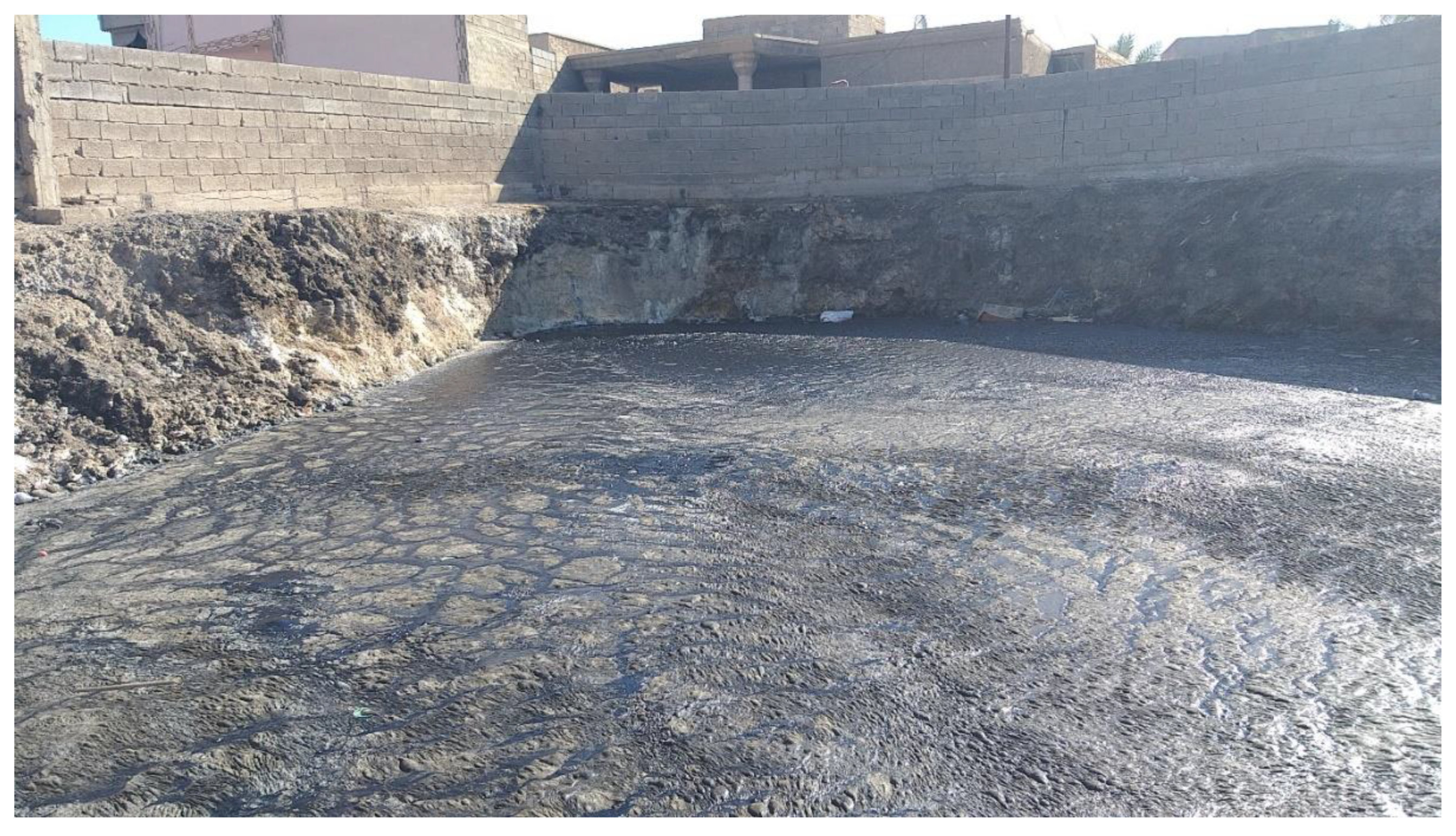
| Location | T°C | pH | EC µS/cm | Ca | Mg | Na | K | Cl | SO4 | HCO3 | NO3 | SI calcite |
|---|---|---|---|---|---|---|---|---|---|---|---|---|
| Haqlaniyah [8,50] |
29 29-29 3[8] |
7.2 7.1-7.3 3 |
5068 5038-5523 3 |
312 288-320 3 |
144 134-146 3 |
251 230-709 7 |
22 21-94 3 |
1620 643-1925 7 |
674 403-1260 7 |
265 223-270 3 |
3 2-3 3 |
0.46 0.29 - 0.5 3 |
| Hit-Kubaysa [8,10,12,29,50] |
27 16-34 49 |
7.2 6.0-7.8 48 |
7100 1800-35418 23 |
400 225-1783 21 |
210 94-607 21 |
619 200-6876 27 |
85 5-540 21 |
1488 320-16100 45 |
480 91-3120 45 |
197 85-1380 21 |
7 2-10 8 |
0.31 -1.54 - 2.1 21 |
| Najaf [9,11,50] |
25 23-27 20 |
7.2 6.9-7.8 20 |
2360 1820-3200 20 |
188 112-326 10 |
185 46-342 10 |
271 203-457 13 |
54 41-74 9 |
588 350-2591 13 |
785 538-1765 13 |
116 45-140 9 |
-0.19 -1.11 - 0.69 9 |
|
| Shinafiyah [63] |
7.7 7.0-8.0 12 |
4815 4010-6080 12 |
391 346-496 12 |
242 160-294 12 |
817 690-1094 12 |
2610 1330-2861 12 |
178 121-211 12 |
0.77 -0.18 - 1.15 12 |
||||
| Riyadh rainfall [47] |
32 | 2 | 6 | 2 | 10 | 17 |
Disclaimer/Publisher’s Note: The statements, opinions and data contained in all publications are solely those of the individual author(s) and contributor(s) and not of MDPI and/or the editor(s). MDPI and/or the editor(s) disclaim responsibility for any injury to people or property resulting from any ideas, methods, instructions or products referred to in the content. |
© 2024 by the authors. Licensee MDPI, Basel, Switzerland. This article is an open access article distributed under the terms and conditions of the Creative Commons Attribution (CC BY) license (http://creativecommons.org/licenses/by/4.0/).





